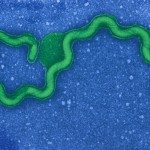Lien vers Pubmed [PMID] – 27141082
Infect. Immun. 2016 May;
The pathogen Leptospira interrogans is a highly motile spirochete that causes acute and fulminant infections in humans and other accidental hosts. Hematogenous dissemination is important for infection by this pathogen, but remains poorly understood because few animal model studies have used sensitive tools to quantify bacteria. We evaluated the kinetics of leptospiral infection in Golden Syrian hamsters by a sensitive quantitative real time PCR (TaqMan) with lipl32 as the target gene. The dissemination and bacterial burden was measured after intraperitoneal infection with a high dose (10(8) leptospires) or low dose (2.5 x 10(2) leptospires). We also examined the conjunctival challenge route to mimic the natural history of infection. Quantification of leptospires in perfused animals revealed that pathogens were detected in all organs of intraperitoneally infected hamsters including the eye and brain within 1 hour after inoculation of 10(8) virulent L. interrogans Peaks of 10(5)-10(8) leptospires/g or/mL were achieved in blood and all tissues between day 4 and day 8 after intraperitoneal inoculation of a high and low dose challenge, respectively, coinciding with macroscopic and histological changes. The conjunctival route resulted in a delay in the time to peak organ burden in comparison to intraperitoneal infection, indicating that although infection can be established, penetration efficiency was low across this epithelial barrier. Surprisingly, infection with a high inoculum of a high passage attenuated L. interrogans strains resulted in dissemination in all organs in the first 4-days post-infection, albeit at a lower burden, followed by clearance from the blood and organs 7-days post-infection and survival of all animals. These results demonstrate that leptospiral dissemination and tissue invasion occur. In contrast, development of a critical level of tissue burden and pathology are dependent on the virulence of the infecting strain.

